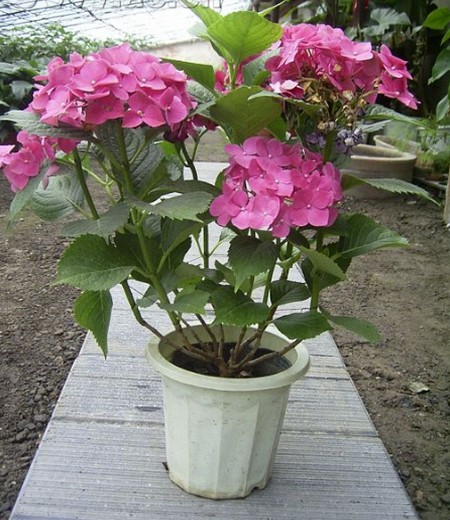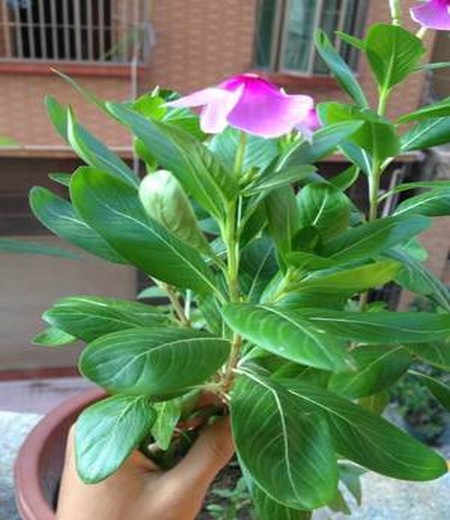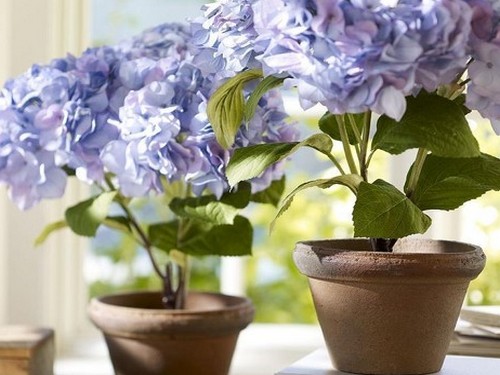Culture methods and matters needing attention of potted eight Immortals (Hydrangea)
There are a variety of breeding methods for eight Immortals (Hydrangea). Let's start with the most familiar ones. Cutting, this method is unknown to everyone, which is like inadvertently cutting willow into shade. Cut off the fresh shoots at the top and insert them into the soil at about 15 degrees in spring. The second method is the striping method, which is similar to the first method, except that the branch is not cut off from the mother, it is carried out when the bud germinates, it can grow after 30 days, and it is cut off with the mother plant in the following spring, and it can blossom in the same year.

Then there is the method of dividing plants. in early spring, the branches of the roots are separated from the mother plant and planted directly into the soil, but pay attention to careful maintenance in the semi-shade, waiting for germination. The last one is organizational reproduction, which is more advanced and cannot be used by ordinary families. Using dormant buds as explants, adventitious buds were cultured on MS medium supplemented with 6-benzylaminoadenine 0.8mg / L and indole acetic acid 2mg / L after regular disinfection. When the seedling height was 2cm to 3cm, it was transferred to 1/2MS medium supplemented with indole acetic acid 2.0mg / L, and grew into complete plantlets.
1. Soil selection
In early spring, the cuttings of eight Immortals (Hydrangea) seedlings can be transplanted into the basin. When potting, it is appropriate to use 4 parts of rotten leaf soil, 3 parts of garden soil, 2 parts of river sand and 1 part of cake fertilizer, or 4 parts of compost soil, 5 parts of sand soil and 1 part of cake fertilizer, or 6 parts of rotten leaf soil, 3 parts of sand (or slag) and 1 part of cake fertilizer. Pour water into the basin, put it indoors for maintenance, and leave the room in early May. The flower color is affected by soil acidity and alkalinity, acid soil flower is blue, alkaline soil flower is red.
2. Lighting requirements
The eight immortals (hydrangea) like the shade. After leaving the room in spring, they should be kept in a semi-shady environment and moved to a well-ventilated shady place in midsummer to prevent sunburn in the leaves. After September, the light intensity weakens day by day. In order to promote flower bud differentiation, the flowerpot should be moved to a place with more light. When the light is too strong in midsummer, proper shading can prolong the flowering period.
3. Temperature requirement
The optimum temperature for the growth of Hydrangea is 18-28 ℃, and the winter temperature is not lower than 5 ℃. Flower bud differentiation takes 6-8 weeks under the condition of 5-7 ℃. The temperature of 20 ℃ can promote flowering, maintain 16 ℃ after anthesis, and prolong the flowering period. But the heat makes the flowers fade quickly.
4. Watering method
Potted eight Immortals (Hydrangea) are commonly used in pots of 15cm and 20cm. Potted plants should be fully watered after sprouting in spring to ensure that the leaves do not wither. The leaves of eight Immortals (Hydrangea) are larger and require more water. The basin soil should be watered frequently in spring and summer to keep the basin soil moist; water should be watered once in the morning and evening in midsummer, and pay attention to proper shade; less watering in winter, as long as the humidity of the basin soil can be maintained; during the growing period, the basin soil should be watered enough to keep the basin soil moist, especially in summer.
From May to August, in addition to meeting the water needs of the basin soil, it is necessary to spray water on the leaves once a day. But the eight immortal flowers (hydrangea) are fleshy roots, and they should not be watered too much, and too much water can easily cause rotten roots. The weather is getting cooler after September, so it is necessary to gradually reduce the amount of water to make the branches grow strong so as to facilitate dormancy in winter.
5. Fertilization method
Eight immortal flowers (hydrangea) like fertilizer, during the growth period, generally every 15 days or so should apply thin pancake fertilizer and water. In order to keep the acid reaction of the basin soil, 0.2% ferrous sulfate can be added when applying liquid fertilizer to turn it into alum fertilizer. The application of 0.5% superphosphate soaking solution twice during the bud period can promote the flower to be large and colorful. During the flowering period from June to July, adequate fertilizer and water should be applied once a month or Huiyou 21 Mel 7 should be used as acid fertilizer.
6. Techniques for changing pots
The eight Immortals (Hydrangea) should change the pot every 1 ~ 2 years in early spring, into the new culture soil, preferably every spring. Remove part of the old soil and rotten roots when changing the basin, and trim it with the change of the basin.
7. Pick the heart and trim
When the new branch grows to about 10-15 cm, it can be coring and promote branching; when the branch grows to 8-10 cm, the second coring will be carried out to facilitate the plant shape to be symmetrical. After September, the flower buds differentiate, cut the branches short in time after the flowers are shedding, promote the growth of new branches, and then pick out the heart when the new branches grow to 8 cm to 10 cm, so as to enrich the new branches and buds to facilitate flowering in the coming year. The stem of the flower is removed after flowering to promote the formation of new branches. Trim properly to keep the plant shape beautiful.
After that, the diseased and weak branches should be cut off from the base in early spring and March every year, and 3-5 strong main branches should be retained and cut short, with 2-3 buds in each branch to promote new branches and make them bloom and flourish. Through pruning and shaping, the tree can be compact, plump, symmetrical, with many flowers, large flowers and bright colors. If not pruned, the base of the old branch of more than 3 years has been lignified, and it is not easy to germinate new branches, which is easy to form the emptiness in the lower part of the plant and affect the ornamental value.
Note:
Hydrangea (Hydrangea) is not only a kind of beautiful flower, but also a good plant with decorative effect, which is widely planted in gardens and other decorations. in addition, Hydrangea can also be used as medicine. It has the effect of treating heart disease and so on. But it should be noted that because the stems and leaves of Hydrangea (Hydrangea) have certain toxicity, and the flowers of Hydrangea (Hydrangea) are easy to make people allergic, so Baxian (Hydrangea) should not be placed indoors, especially in the bedroom for breeding. Friends who like to grow flowers should pay attention to these problems.
Then pay attention to the cultivation process of eight immortals (hydrangea) like warm and humid, do not tolerate drought, but also avoid waterlogging; like semi-shade environment, not cold-resistant, suitable for growing in fertile, well-drained acidic soil. Often watering alum fertilizer and water can make the plant branches and leaves green.
Insect pests are mainly aphids, which can be washed with folk prescription and cigarette butt soaking water, which is more effective, or sprayed with 1500 times omethoate EC.
Prevention and treatment of common diseases of eight Immortals (Hydrangea):
1. Hydrangea thrips disease
In the cultivation of hydrangea, it is necessary to strengthen the prevention of diseases and insect pests of thrips.
Control methods: flower thrips should be used before flowering with good winter or imidacloprid control, on it. Flowering management should keep sufficient soil moisture and light to prolong the viewing period of hydrangea. After the flowers fade, cut short the branches and promote the new branches to blossom in the coming year.
2. Botrytis cinerea
In the cultivation of hydrangea, the prevention of Botrytis cinerea diseases and insect pests should be strengthened.
Flowering management should keep sufficient soil moisture and light to prolong the viewing period of hydrangea. After the flowers fade, cut short the branches and promote the new branches to blossom in the coming year.
3. Hydrangea hydrangea
Hydrangea has few diseases and insect pests, but there are few diseases and insect pests in early spring.
Prevention and treatment: only sporadic bugs appear in early spring, which can be killed with 1000 times liquid medicine. Flowering management should keep sufficient soil moisture and light to prolong the viewing period of hydrangea. After the flowers fade, cut short the branches and promote the new branches to blossom in the coming year.
4. Hydrangea red spider
In the cultivation of hydrangea, it is necessary to strengthen the prevention of red spider diseases and insect pests.
Control methods: red spiders are prevented by aphids and mites. Flowering management should keep sufficient soil moisture and light to prolong the viewing period of hydrangea. After the flowers fade, cut short the branches and promote the new branches to blossom in the coming year.
Time: 2019-06-01 Click:
- Prev

How to raise Catharanthus roseus? Culture techniques of Catharanthus roseus
Catharanthus roseus has a long flowering period, beautiful colors and beautiful posture, and with the development of modern technology, the varieties of Catharanthus roseus cultivated by people are becoming more and more beautiful, which is very suitable for indoor potted ornamental plants. Raising a pot at home may have an unexpected effect. So how to plant Catharanthus roseus well
- Next

How to raise potted Hydrangea / eight Immortals
The eight Immortals (scientific name: Hydrangeamacrophylla), also known as Hydrangea and Ziyang Flower, belongs to the genus Saxifragaceae. The eight Immortals flowers are white and plump, large and beautiful, and their colors can be red and blue, pleasing to the eye and spirit. They are common potted ornamental flowers and trees.
Related
- Fuxing push coffee new agricultural production and marketing class: lack of small-scale processing plants
- Jujube rice field leisure farm deep ploughing Yilan for five years to create a space for organic food and play
- Nongyu Farm-A trial of organic papaya for brave women with advanced technology
- Four points for attention in the prevention and control of diseases and insect pests of edible fungi
- How to add nutrient solution to Edible Fungi
- Is there any good way to control edible fungus mites?
- Open Inoculation Technology of Edible Fungi
- Is there any clever way to use fertilizer for edible fungus in winter?
- What agents are used to kill the pathogens of edible fungi in the mushroom shed?
- Rapid drying of Edible Fungi

